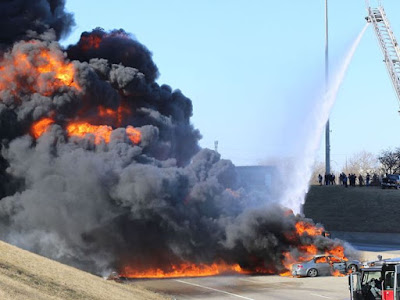Wednesday, June 10, 2015
With legal repercussions anticipated regardless of her
decision, Dianne Black denied on Tuesday an emergency permit filed by
ExxonMobil to truck crude oil from Las Flores Canyon Facility along Highway 101
to a refinery about 70 miles north.
Since Plains All American Pipeline’s Line 901 ruptured last
month, spilling about 100,000 gallons of crude onto the Gaviota Coast, a
10.6-mile stretch of the 24-inch pipeline has been effectively shut down. This
has forced Exxon to cut its production to about 10,000 barrels of oil a day,
but in about two weeks, Exxon says it will exhaust its storage capacity.
Submitted on June 4, Exxon’s application proposed a maximum
of eight trucks an hour — 24 hours a day, 7 days a week — each carrying 6,720
gallons of crude oil. As assistant director of the county’s Planning and
Development (P&D), Black became sole decision-maker after P&D director
Glenn Russell recused himself because he used to own stock in ExxonMobil; he
divested it in the last few months, he said Monday.
Whether or not it is safe to transport crude on the highway
depends on whom you ask. On Sunday evening, the county chief executive’s office
opened the matter up for public comment; several dozen people wrote in less
than 48 hours.
Environmentalists — including Center for Biological
Diversity and newly formed Food & Water Watch — all but threatened a
lawsuit if the county approved the emergency permits. They advocated for the
customary permit process with proper environmental review. Two dozen or so
activists rallied against trucks Monday afternoon at the courthouse, holding
colorful signs that read “End Oil Now” and calling for clean energy.
Meanwhile COLAB’s Andy Caldwell took exception, calling it
“absolutely incredulous” to oppose trucking a raw product on the freeway when
gasoline is always tankered on the highway. In a similar school of thought,
City Councilmember Dale Francisco said in an op-ed at independent.com, “Absent
a scientific breakthrough,” modern industrial societies will continue to rely
on fossil fuels. ExxonMobil spokesperson Dick Keil pledged the company would
have used a new fleet with safer containers and fewer carbon emissions.
Exactly what constitutes an “emergency” was the endgame for
Black. According to county zoning codes, an emergency is a “sudden unexpected
occurrence demanding immediate action to prevent or mitigate loss or damage to
life, health, property, or essential public services.” Exxon claimed, if shut
down, its production of natural gas — separated from the oil and produced
water, and scrubbed clean of hydrogen sulfide — would cease. This natural gas
is supplied to residents in Santa Barbara, San Luis Obispo, and Ventura, and
constitutes a public utility, Exxon claimed.
Not so, said Black. Based on a 2014 gas company report,
Exxon provided less than one percent of Southern California Gas’s total supply
last year. Plus, she wrote, the county permitted a storage expansion project
for the gas company. Black found Exxon’s second argument — tax revenues —
equally flawed.
Exxon generated nearly $4.2 million in taxes last year from
its three offshore platforms, according to company spokesperson Keil. “That’s
revenue that the county will have to make up on a monthly basis,” Keil said.
Santa Ynez Valley High and Vista Del Mar school districts each rake in more
than $700,000 from Exxon’s property taxes, according to Keil.
But school districts can file a claim with Plains, Black
wrote; entities or individuals have three years to do so. Black also found that
trucking oil does not fall within the emergency permits allowed by Governor
Jerry Brown’s executive order regarding the oil spill.
“We are obviously disappointed in their decision,” Keil said
Tuesday afternoon. “We are in the process of studying their response,” he said,
without indicating Exxon’s next steps. Because the decision for the emergency
application is not appealable, Exxon could take the matter to court. Otherwise,
Exxon can apply for a customary permit, a months-long process that consists of CEQA
review, policy analysis, and a public hearing.
Venoco — much smaller than ExxonMobil — was forced to shut
down its 4,000-barrel production about a week after the spill. Venoco is
currently evaluating transportation options, said spokesperson Keith Wenal, and
is using the downtime to complete annual safety inspections.
On June 26 at 2 p.m., Assembly member Das Williams and State
Senator Hannah-Beth Jackson will hold a joint oversight hearing to look at the
cause and response to the oil spill at the County Administration Building. Last
week, Representative Lois Capps formally asked Rep. Fred Upton (R-MI), chair of
the House Energy and Commerce Committee, for a field hearing in Santa Barbara.
Also, a congressional committee is expected to review pipeline standards later
this year.
Source:http://www.independent.com







